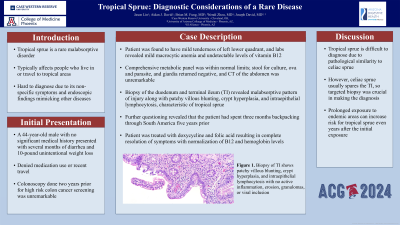Tuesday Poster Session
Category: Small Intestine
P4983 - Tropical Sprue: Diagnostic Considerations of a Rare Disease
Tuesday, October 29, 2024
10:30 AM - 4:00 PM ET
Location: Exhibit Hall E

Has Audio

Jason Lin
Case Western Reserve University
Brooklyn, NY
Presenting Author(s)
Jason Lin, 1, Aidan J. David, 2, Brian M.. Fung, MD3, Joseph David, MD4
1Case Western Reserve University, Brooklyn, NY; 2Case Western Reserve University, Cleveland, OH; 3Arizona Digestive Health, Mesa, AZ; 4University of Arizona College of Medicine, Phoenix, AZ
Introduction: Tropical sprue is a rare malabsorptive disorder primarily affecting individuals who live in or travel to tropical areas such as the Caribbean or Southeast Asia. The syndrome is characterized by diarrhea, weight loss, steatorrhea, nausea, and abdominal cramping, and frequently leads to vitamin B12, folate, iron, and other essential nutrient deficiencies. The diagnosis is often difficult due to its non-specific symptoms and endoscopic findings mimicking other conditions. Here, we discuss the intricacies of diagnosing tropical sprue in a patient who traveled to South America 5 years prior.
Case Description/Methods: A 44-year-old male with no significant medical history presented with several months of diarrhea and a 10-pound unintentional weight loss. He denied medication use or recent travel within the past year, and a screening colonoscopy performed for a family history of colon cancer 2 years prior was unremarkable. On exam, he had mild left lower quadrant tenderness. Lab testing revealed hemoglobin 12.9, MCV 107, and undetectable vitamin B12 level. A comprehensive metabolic panel, celiac serologies, thyroid stimulating hormone, iron studies, folate, anti-parietal cell and intrinsic factor antibodies, and C-reactive protein were within normal limits. Stool culture, ova and parasite, and giardia were negative. CT of the abdomen/pelvis was unremarkable. B12 replacement was initiated, and EGD and colonoscopy were endoscopically unremarkable with normal gastric and colonic biopsies. However, biopsies of the duodenum and terminal ileum (TI) revealed a malabsorption pattern of injury, with patchy villous blunting, crypt hyperplasia, and intraepithelial lymphocytosis, strongly suggestive of tropical sprue. On further questioning, the patient reported having backpacked through northern South America for 3 months 5 years prior. He was started on doxycycline and folic acid, with complete resolution of symptoms within a few days. Vitamin B12 level and CBC returned to normal.
Discussion: Tropical sprue is difficult to diagnose as villous blunting in the duodenum can be seen in other conditions like celiac sprue. However, tropical sprue can involve the entirety of the small bowel, whereas celiac typically spares the TI. Hence, a biopsy of the TI was crucial in making the diagnosis for our patient. Furthermore, prolonged exposure to endemic areas can increase the risk of tropical sprue even years after the initial exposure highlighting the need to inquire about such travel in the proper clinical setting.
Disclosures:
Jason Lin, 1, Aidan J. David, 2, Brian M.. Fung, MD3, Joseph David, MD4. P4983 - Tropical Sprue: Diagnostic Considerations of a Rare Disease, ACG 2024 Annual Scientific Meeting Abstracts. Philadelphia, PA: American College of Gastroenterology.
1Case Western Reserve University, Brooklyn, NY; 2Case Western Reserve University, Cleveland, OH; 3Arizona Digestive Health, Mesa, AZ; 4University of Arizona College of Medicine, Phoenix, AZ
Introduction: Tropical sprue is a rare malabsorptive disorder primarily affecting individuals who live in or travel to tropical areas such as the Caribbean or Southeast Asia. The syndrome is characterized by diarrhea, weight loss, steatorrhea, nausea, and abdominal cramping, and frequently leads to vitamin B12, folate, iron, and other essential nutrient deficiencies. The diagnosis is often difficult due to its non-specific symptoms and endoscopic findings mimicking other conditions. Here, we discuss the intricacies of diagnosing tropical sprue in a patient who traveled to South America 5 years prior.
Case Description/Methods: A 44-year-old male with no significant medical history presented with several months of diarrhea and a 10-pound unintentional weight loss. He denied medication use or recent travel within the past year, and a screening colonoscopy performed for a family history of colon cancer 2 years prior was unremarkable. On exam, he had mild left lower quadrant tenderness. Lab testing revealed hemoglobin 12.9, MCV 107, and undetectable vitamin B12 level. A comprehensive metabolic panel, celiac serologies, thyroid stimulating hormone, iron studies, folate, anti-parietal cell and intrinsic factor antibodies, and C-reactive protein were within normal limits. Stool culture, ova and parasite, and giardia were negative. CT of the abdomen/pelvis was unremarkable. B12 replacement was initiated, and EGD and colonoscopy were endoscopically unremarkable with normal gastric and colonic biopsies. However, biopsies of the duodenum and terminal ileum (TI) revealed a malabsorption pattern of injury, with patchy villous blunting, crypt hyperplasia, and intraepithelial lymphocytosis, strongly suggestive of tropical sprue. On further questioning, the patient reported having backpacked through northern South America for 3 months 5 years prior. He was started on doxycycline and folic acid, with complete resolution of symptoms within a few days. Vitamin B12 level and CBC returned to normal.
Discussion: Tropical sprue is difficult to diagnose as villous blunting in the duodenum can be seen in other conditions like celiac sprue. However, tropical sprue can involve the entirety of the small bowel, whereas celiac typically spares the TI. Hence, a biopsy of the TI was crucial in making the diagnosis for our patient. Furthermore, prolonged exposure to endemic areas can increase the risk of tropical sprue even years after the initial exposure highlighting the need to inquire about such travel in the proper clinical setting.
Disclosures:
Jason Lin indicated no relevant financial relationships.
Aidan J. David indicated no relevant financial relationships.
Brian Fung indicated no relevant financial relationships.
Joseph David indicated no relevant financial relationships.
Jason Lin, 1, Aidan J. David, 2, Brian M.. Fung, MD3, Joseph David, MD4. P4983 - Tropical Sprue: Diagnostic Considerations of a Rare Disease, ACG 2024 Annual Scientific Meeting Abstracts. Philadelphia, PA: American College of Gastroenterology.
